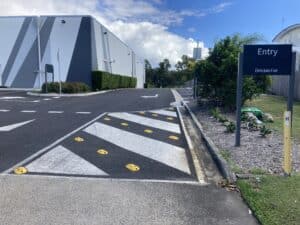

Our commitment to safety must prioritize the youngest members of our community. Developing a comprehensive roadmap for parents, educators, and childcare providers to incorporate road safety education into preschool curricula is essential. By using interactive games and hands-on activities, we can make road safety education both engaging and impactful for children.
Teaching kids about road safety from an early age lays a strong foundation for lifelong awareness and safety.
Early cognitive growth is like a sponge soaking in water—rapid and absorbent. Introducing road safety principles during this key developing age has many cognitive benefits. Teaching students to recognise traffic signs is just the beginning of developing good decision-making skills.
Early road safety instruction improves attention, memory, and executive function. It develops spatial awareness, cause-and-effect understanding, and instruction following, which are essential for safe road behaviour. Beyond the road, cognitive benefits give youngsters lifelong abilities that promote holistic development.
“Start early, start right” applies to lifelong practices, including road safety. Early education impacts the child’s views and behaviours. As they mature, a child’s early lessons shape their behaviour.
Research constantly emphasises early interventions in forming long-term habits. Early road safety education fosters a lifelong safety culture. Children who get early road safety education are more likely to be careful pedestrians, cyclists, and drivers as adults.
Statistics on child road accidents motivate us to act proactively. Young children’s brains have great potential for growth and understanding thanks to early instruction. Starting safety behaviours early makes roadways safer and society more aware.
We must discover creative ways to teach kids about traffic signs using educational and entertaining interactive games. These activities will make road safety fun for preschoolers, from Traffic Sign Bingo to a Scavenger Hunt to making homemade traffic signs.
Imagine the pleasure of Bingo and discovering new traffic signs. Interactive Traffic Sign Bingo makes a simple game educational. Traffic sign bingo cards are given to kids, players mark signs on their cards as they are called. This improves sign recognition and adds friendly rivalry. Use photographs or small models of traffic signs as markers to make it more interesting. Road safety teaching is fun and engaging with this game.
Join a Traffic Sign Scavenger Hunt for an adventure. Turn your neighbourhood or play area into a road safety resource. Give kids a list of traffic signs to find. With this list, they become detectives, searching for stop signs, pedestrian crossing signs, and more. This activity reinforces their sign knowledge and trains students to spot signs in real life. Offering modest prizes for each sign found adds fun.
 This hands-on project lets kids design their road safety world by making traffic signs. Give them cardboard, paints, and markers. Encourage children to make traffic signs. This boosts their inventiveness and helps them understand each sign’s meaning. Once made, the signs can be posted in a classroom or play area’s improvised roadway to create an informative and visually interesting micro-traffic scenario.
This hands-on project lets kids design their road safety world by making traffic signs. Give them cardboard, paints, and markers. Encourage children to make traffic signs. This boosts their inventiveness and helps them understand each sign’s meaning. Once made, the signs can be posted in a classroom or play area’s improvised roadway to create an informative and visually interesting micro-traffic scenario.
Road safety instruction is much more fun with creativity. These fun traffic sign games teach the meaning of each sign and spark curiosity. Traffic Sign Bingo, Scavenger Hunts, and Homemade Signs teach young learners about road safety and foster a lifetime awareness of the rules of the road.
We need creative and interactive ways to teach kids about pedestrian safety. Role-playing pedestrian scenarios, incorporating traffic lights into games, and enjoying playground zebra crossings are all possibilities. Our young adventurers learn pedestrian safety and are inspired by these activities.
Engage in role-playing to teach pedestrian safety. Let kids play the role of pedestrians, drivers, and traffic officers. They can simulate real-life events with this interactive activity. Role-playing brings traffic laws to life, whether at a pedestrian crossing or a traffic light. This hands-on approach improves pedestrian safety knowledge and responsibility.
Make traffic lights into a fun game for kids. Label play spaces “crosswalks” and “waiting zones.” Create traffic lights using items or drawings. Children can alternate as “pedestrians” waiting for the signal. This game emphasises traffic signals, patience, and safe crossings. We smoothly integrate safety teachings into their playtime by incorporating play.

Introduce zebra crossings to make the playground a colourful learning canvas. Draw chalk zebra crossings in selected spots to create a tiny road network for kids. Help them cross securely by stopping, looking, and listening. This hands-on practice promotes zebra crossing awareness, coordination, and physical activity. We make pedestrian safety fun by mixing learning and play.
Play and imagination make pedestrian safety fun. We teach road regulations and promote pedestrian safety by role-playing, incorporating traffic signals into games, and adding zebra crossings to the playground. Such activities foster responsible and aware pedestrians.
We need to make road safety principles tangible for young learners by making roadway mats, adding toy cars and pedestrians, and creating realistic scenarios.
Make a DIY highway mat to start our hands-on learning experience. This simple yet effective activity turns fabric or cardboard into a small road network. Create lanes, intersections, and pedestrian crossings with coloured tape. Show road signs with cartoons or cutouts. This DIY mat creates a dynamic learning place where kids may physically practise road safety. Involving children in the creation process fosters ownership and curiosity about the roads they will explore.
After finishing our roadway mat, add toy automobiles and pedestrians. Offer a choice of toy vehicles depicting different kinds of transportation. Use small pedestrians to emphasise road sharing. Children may act out scenarios, grasp traffic flow, and practise safe road behaviours in this interactive play. By merging these aspects, we make learning entertaining and promote comprehensive road environment awareness.
Create realistic scenarios on our small roadways to enhance learning. Challenge them with a busy crossroad, pedestrian crossing, or roundabout. Teach kids to recognise and handle diverse driving situations. Stress safe interaction between automobiles and pedestrians and simplify right of way. These hands-on experiences deepen road safety knowledge beyond theory.
Building small streets for hands-on learning transforms road safety teaching. We encourage youngsters to actively learn about road safety by making roadway mats, adding toy automobiles and pedestrians, and creating realistic scenarios.
We face a major curve in road safety education—tailoring activities for different age groups. This can be done by tailoring activities for toddlers, preschoolers, and pre-kindergarteners to their needs and cognitive development. Road safety education is not uniform.
We must tailor our approach to different age groups because one size doesn’t fit all.
Sensory activities for toddlers. Road-themed play mats with textured materials introduce touch and feel. Simple, large-sized toys help promote basic awareness.
Moving on to interactive games like Traffic Sign Bingo helps preschoolers correlate shapes and colours with meanings. Paper traffic sign-making improves fine motor skills and creativity.
fine motor skills and creativity.
Tell simple road stories to pre-kindergarteners. Visuals and talks can promote traffic light waiting and safe crossing. Interactive apps and games can add a tech-savvy touch.
Each child’s growth is unique, thus our approach must be nuanced.
Cognitive Development Stages: Early on, emphasis needs to be placed on sensory experiences. Introduce more sophisticated concepts like road signs and symbols as they advance. Explore practical situations and decision-making with older youngsters.
Customise activities for children with sensory, visual, or auditory demands. Support as needed and provide an inclusive learning environment.
Apply theory with age-appropriate examples.
Toddlers: Textured road play mats introduce fundamental road shapes and colours.
Traffic Sign Bingo includes large, colourful cards for preschoolers. Simple traffic sign workshops utilising safe materials.
Preschoolers: Visual storytelling and road safety discussions. Road simulation applications or games.
Adapting road safety initiatives for different age groups is like traversing different terrains. We make road safety instruction fun and instructive for toddlers, preschoolers, and pre-kindergarteners by knowing their needs and development.
We must examine how parents shape their children’s road safety habits. From becoming role models to encouraging open conversation and providing resources. Understanding the dynamic cooperation between parents and educators is crucial to making roads safer for our young learners.
A child’s first and most important teacher is their parents. Role models shape behaviour and attitudes, especially with road safety.
Ride safely by wearing seatbelts, following traffic laws, and respecting pedestrian crossings. Children observe closely, so modelling safe behaviour leaves a lasting impression.
Open Dialogue: Discuss your walking, cycling, and driving experiences. Share stories about driving safely and respecting the rules. It links theoretical learning to practical applications.
Road safety lessons are brought to life by good communication. Parenting can promote open communication and constant reinforcement.
Check-ins: Discuss road safety regularly. Discuss what kids are learning in school, answer their questions, and share your own experiences.
Regular Reinforcement: Make road safety a family priority. Consistently emphasise seatbelts, look both ways before crossing, and observe speed limits. Consistency creates habits and character.
Give parents resources to reinforce road safety beyond the classroom.
Online Resources: Offer interactive road safety activities and quizzes online or via applications. These resources may make learning fun while reinforcing topics for kids.
Safety Tips: Give advice about travelling to school, biking riding, and taking public transportation. Practical guidance helps parents handle everyday circumstances with their kids.
Family Safety Pledges: Make a promise to respect traffic laws, wear seatbelts, and walk safely. Make youngsters active partners in the family’s safety commitment.
Parental engagement links classroom learning to road realities. Parents are crucial road safety education partners by setting an example, encouraging open communication, and offering tools.
We should consider integrating road safety into preschool curricula, encouraging community engagement through workshops, and emphasising the benefits of collaborative efforts to make road safety education a community-wide effort for safer roads.
A child’s education begins in preschool, making it a good time to teach road safety.
Integration: Work with preschool teachers to include road safety into their curricula. Make road safety part of a child’s early learning by designing activities that match developmental stages.
Interactive Learning: Use storytelling, role-playing, and hands-on activities. Road safety teachings are better retained when made interactive and fun.
Road safety education can be expanded through community seminars and activities.
Community Workshops: Hold parent, carer, and community workshops. This training can cover everything from child pedestrian behaviour to safe school trips. Workshops allow for open debate and idea sharing.
Organise collaborative events: with local government, law enforcement, and road safety organisations. This increases community knowledge and encourages shared responsibility for safer environments.
Road safety education is most effective when communities work together.
Collaborative initiatives make children’s environments safer. Schools, businesses, and community leaders can work together on safe school zones, crosswalks, and speed limits.
Communities can share resources to generate teaching materials, organise events, and adopt safety measures. Road safety efforts reach more people with shared resources.
Road safety education goes beyond the classroom. We build a safer, more informed community by encouraging pre-schools to incorporate road safety into their curricula, hosting workshops, and highlighting the benefits of collaboration.
From incorporating road safety into preschool curricula to encouraging community engagement and collaboration, the path to safer communities is complex. We must always remember how our efforts affect future generations’ security.
Preschools help children learn road safety since they build their knowledge early on. By encouraging these schools to include road safety in their curricula, we teach young brains important information and build a culture of awareness. These early years programmes are building blocks for lifelong appropriate road use, not just education.
We boost road safety education through workshops, events, and collaborations. Parents and carers exchange insights and commit to safety in workshops. Collective events between local authorities and safety organisations raise awareness. In these public areas, road safety is not only taught but also ingrained in community values.
Collaboration makes road safety education strong. Schools, businesses, community leaders, and road safety organisations working together transform. School zones and speed humps can make places safer. It extends beyond infrastructure to foster a culture where safety is a shared responsibility.
At Speed Hump Australia, we are dedicated to enhancing road safety through innovative and effective solutions. Our commitment to creating safer roads, our comprehensive understanding of the science and psychology behind speed humps, and our track record of successful installations make us your ideal partner in road safety.
Whether you’re looking to improve safety in school zones, transform residential neighbourhoods, or create secure business districts, Speed Humps Australia offers tailored solutions that address your unique needs. Join us in the pursuit of safer roads and a brighter future for all road users.
The road to safer and responsible driving is one we all share, and Speed Hump Australia is here to lead the way.
Get in touch with us today to request a quote or discuss how we can help with providing a tailored solution to your unique project requirements.



For 10 years, our focus has been on one thing: to provide one style of product and to do it well.
Our wheel stops, speed humps and rumble bars meet Australian Standards, don’t fade, and we’ve never needed to replace one.

For 10 years, our focus has been on one thing: to provide one style of product and to do it well.
Our wheel stops, speed humps and rumble bars meet Australian Standards, don’t fade, and we’ve never needed to replace one.